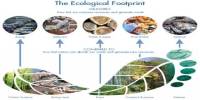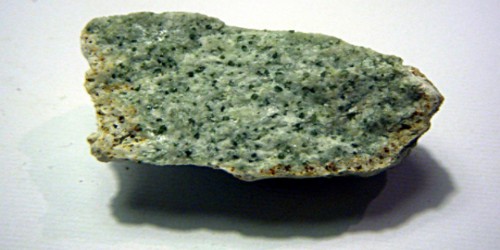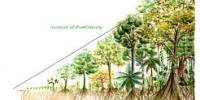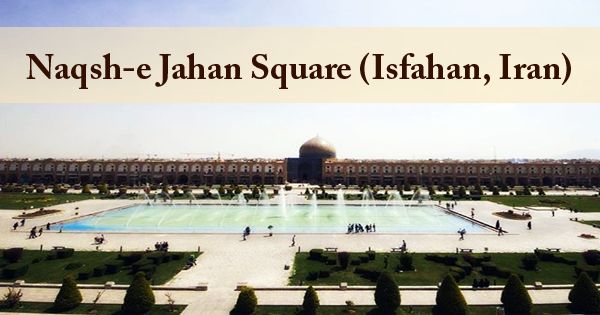The Dallol volcano, or more specifically the Dallol hydrothermal field, is located in a remote section of Ethiopia’s Erta Ale Range, in the northern Danakil Depression. It’s a rift valley that runs parallel to the Red Sea, near the Ethiopian-Eritrean border. The last time the Red Sea was separated was roughly 30,000 years ago. It’s a small structure that’s connected to the rift that separates Africa and the Arabian Peninsula. Dallol is famous for its strange hues and mineral formations, as well as the very acidic fluids that flow from its hydrothermal springs. It is the world’s lowest known sub-aerial volcanic region.
The volcano is located on the Erta Ale axial, a rift section with many active volcanoes, including Erta Ale, which has a permanent lava lake. The circular Dallol, which rises gradually to 60 meters above the salt plain (48 meters below sea level), features a 100-meter-wide summit crater that was formed by a phreatic eruption in 1926. The Afar people invented the name Dallol, which means “dissolution” or “disintegration,” to describe a landscape of green acid ponds (pH values below 1) and iron oxide, sulfur, and salt desert plains. The region is reminiscent of Yellowstone Park’s hot springs.
Dallol mountain is roughly 3 by 1.5 kilometers (1.9 by 0.9 miles) in size and rises 60 meters (196.9 feet) above the surrounding salt flats. The lowest point of the depression is roughly 410 feet below sea level after millions of years of subsidence. It’s one of the planet’s lowest places. A collapsed crater is most likely the circular depression towards the center. Salt canyons, pillars, and blocks have been eroded by water on the southern slopes. There are a lot of salty springs and tiny fumarole fields.
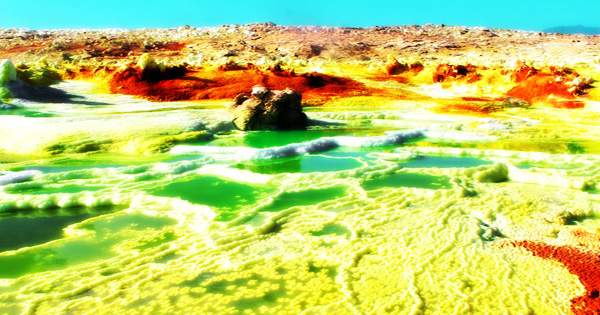
Water has overtopped the barrier between the Danakil Basin and the Red Sea several times throughout the development of the Danakil Depression, filling the basin with seawater. Dallol is one of the most beautiful places in the planet. It is a large region of elevated thick salt deposits with a lot of fumarolic activity, which is most likely generated by an active volcanic system beneath several kilometers of evaporation salt deposits. As the saltwater evaporated in the hot, dry climate, thick evaporite layers of gypsum and halite were formed in the basin. Evaporating runoff water and evaporating hydrothermal brines created some of the evaporite deposits.
Here, a number of hot springs release brine and acidic fluids, and tiny, widespread transient geysers generate salt cones. Significant bodies of potash may be discovered right at the surface in the Dallol deposits. The Dallol region is one of the world’s hottest. The yearly mean temperature is 94 degrees Fahrenheit, with an average daily maximum temperature of 106 degrees Fahrenheit. During the rainy season, runoff water may cover considerable sections of the Danakil depression.
Near the border with Eritrea, the Dallol “mountain” (rising about 50 m above the great salt lake) and nearby warm springs such as the Yellow Lake, the Black Mountain, and the Blue Lake, said to be an explosion crater from a hydrothermal eruption in 1926, make up the area commonly referred to as Dallol volcano. On its journey to the surface, the rising magma body pierced the salt, resulting in a phreatic explosion that created a tiny maar about 100 feet across at the eruption site. The presence of iron and other impurities causes the yellow, ochre, and brown colorings. Because of oxidation processes, older, dormant springs are dark brown.
Salt flats cover a large portion of the Danakil Depression’s floor. Basalt flows, shield volcanoes, and cinder cones cover other regions. On the salt flats, many craters of up to a mile in diameter may be seen. Phreatic eruptions are considered to have created these maars. For most of the twentieth century, Dallol covered many kilometers of quaternary evaporates containing enormous quantities of potash (potassium carbonate, K2CO3) that were mined by changing mining firms. Dallol, which is located on the Danakil depression’s main rift axis, is thought to be generated by an active basaltic volcano under the salt layers.
A collapse crater was postulated for the approximately circular depression on top of Dallol mountain. The intrusion of basaltic magma into Miocene salt deposits, followed by hydrothermal action, created it. Dallol craters are perilous to explore because they can be coated with a crust of salt with pools of boiling acidic water just inches below the surface. Occasionally, toxic gases are emitted by craters. The most recent evidence of activity was discovered in January 2011, perhaps as a result of a degassing event deep under the surface.
Previous phreatic eruptions at Dallol and the surrounding salt plain left bubbling acid brine pools, which can be explained by a number of active maar craters. The deep evaporite succession and numerous marine incursions of the salt plain during the Holocene have hidden the craters. Dallol and its surrounding area is recognized for being one of the driest and hottest areas on the globe. It is also one of the lowest land locations on the planet, at 125 meters (410 feet) below sea level. Yellow (Gaet’Ale) and Black Lakes are two additional recognized hydrothermal phenomena near Dallol.
Tourists have been flocking to Dallol and Erta Ale, volcanic regions in the southeastern portion of the Danakil Depression, in recent years. Anoxic, hyper-acidic (pH <0), hyper-salty (nearly 10 times more saline than seawater), high temperature (> 108 °C (226 °F)) brines with more than 26 g/L iron are discharged from Dallol’s hydrothermal springs. CO2, H2S, N2, SO2, and traces of H2, Ar, and O2 are the primary gas phases released by the springs and fumaroles. Although there are numerous other hyper-acidic (pH <2) volcanic systems, most of which are located in crater lakes and hydrothermal locations, Dallol’s pH values drop well below zero.
In the sedimentary basin, an evaporite succession consists mostly of bedded halite, with minor interbeds of clay shale, gypsum, anhydrite, and a thick bed of potash. Dallol is not yet included as a Unesco World Heritage Site, despite being a natural system of great beauty and aesthetic value that hosts unique geological processes. Hundreds of visitors visit the site each year, but it is neither monitored or safeguarded, posing a threat to both the monument’s long-term growth and the tourists’ safety. Many tour groups are escorted by armed guards.
Information Sources:

